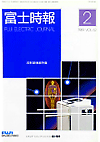FUJI ELECTRIC JOURNAL Vol.62-No.2 (Feb/1989)
 |
Nuclear Radiation Instruments |
Present Status and Prospects of Nuclear Instrument Industry
Kiyoji Yamaguchi
This paper describes the present technology and future technical prospects of nuclear system instruments, monitors, and applied instruments on the basis of the medium-term sales forecast of classified radiation apparatus by Japan Electric Measuring Instrument Manufacturer's Association.
Though the sales were only about 18.9 billion yen in 1988 particularly due to the aftereefect of dull trade in 1987, the basic condition was set upward from 1988 and they are estimated at 28 billion yen in 1991 on the assumption that monitor-oriented computer systems will become large in scale.
Though the sales were only about 18.9 billion yen in 1988 particularly due to the aftereefect of dull trade in 1987, the basic condition was set upward from 1988 and they are estimated at 28 billion yen in 1991 on the assumption that monitor-oriented computer systems will become large in scale.
Radiation Detectors
Yoshiteru Yoshida, Toshikazu Suzuki, Yuji Takenaga
Fuji Electric has fabricated wide-ranging detectors for radiation monitors and instruments in nuclear power plants. This paper outlines the principles, characteristics, purposes, specifications, and experimental results of those detectors and particularly of those developed by the company in recent years. Here cited are the ionization chambers of pressurized type for γ rays and of air-flow type for β rays, 3He and BFs proportional counters for neutrons, large area gas-flow counters for β rays, GM counters and large area plastic scintillation detectors, along with silicon detectors for pocket alarm dosemeters, surveymeters, area monitors, and β and α-ray measurement with large area and neutron pocket dosemeters, respectively.
Nuclear Radiation Meters and Monitor Modules
Yoshiyuki Nagase, Seini Yamamura, Kaoru Masui
Radiation instruments are roughly classified into meters that incorporate radiation detectors (e.g. surveymeters) and receiving instruments that process signals independently and indicate or display the results (e.g.radiation monitoring modules).This paper describes the configurations and features of these instruments and also introduces optical-fiber applied radiation monitoring instruments developed recently.
Radiation Monitors
Haruo Tanaka, Saburo Kiyose, Keisuke Koga
The fundamentals of protection from radiation in nuclear power plants and other facilities handling radioactivity consist in managing operation and taking necessary measures to keep the workers and residents in and around those facilities safe enough from exposure to radiation due to the facilities operation. This paper, classifying radiation monitors used for radiation control into three groups of process monitors (emission control monitors), working environment monitors, and peripheral environment monitors, introduces the configurations and specifications of the typical examples each with a simple system diagram.
Radioactive Contaminant Monitors
Toshiaki Takechi, Ryohei Yanagishima, Hironobu Kobayashi
Body surface monitors, article monitors, and laundry monitors are typical measuring equipment for inspecting the radioisotopic contamination of body and article surfaces in nuclear power plants. Recent monitors equipped with microprocessors have become highly sensitive and easy to use with their procedure illustrating and failure diagnostic functions by CRTs and data processing functions. This paper introduces the system configuration, characteristics and functions of whole-body counters and lung monitors for measuring the radioactive deposit in the body and calibrators for survey meters, in addition to the above monitors.
Radiation Management System
Masanori Aoki, Eiichi Mihoya, Makoto Chigira
Since strict radiation management in nuclear power plants includes various kinds of work and handles quantities of information, labor saving is urgently required.
This paper introduces the organization and management of a large-scale centralized radiation management system using two superminicomputers aiming at "the integrated automation of radiation management" in nuclear power plants.
This paper introduces the organization and management of a large-scale centralized radiation management system using two superminicomputers aiming at "the integrated automation of radiation management" in nuclear power plants.
Image Processing Display System FIID Series
Masahiko Oka, Yoshihiro Ikawa, Mitsuyoshi Nakatani
Fuji intelligent Image Display (FIID) series is an image processing display system which can efficiently process and display monochrome and full-color images.
This paper introduces the background of the development, an outline for the hardware and software, features, and actual applications of FIID-12BL (for monochrome) and FIID-24BLT (for full color) newly developed.
This paper introduces the background of the development, an outline for the hardware and software, features, and actual applications of FIID-12BL (for monochrome) and FIID-24BLT (for full color) newly developed.
Highly Functional Color Graphic Display
Hideiku Horiike, Fukashi Koyama
Graphic display has played an important role in monitoring operating conditions in control systems. The control systems are getting highly functional according to the diversification of objects to be controlled and operating conditions. Efficient operation of these control systems requires improved man-machine interfaces enabling operators to deal with more information speedily. This paper outlines the feature, function and software support of the highly functional color graphic display FIVC-800 developed to meet such requirements.

